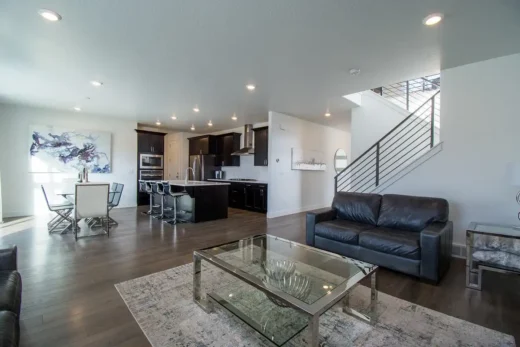Open floor plan guide, House space without walls, Property room design advice
Open Floor Plan? Here’s How to Define Each Space Without Walls
3 July 2025
Open floor plans have become a hallmark of modern living. They offer bright, airy spaces, better flow between rooms, and a natural gathering point for everyday life. But with that openness can come a unique design challenge: how do you create distinct zones for living, dining, working, and cooking—without the use of walls?
When every area blends into the next, it’s easy for a home to feel chaotic or undefined. Fortunately, you don’t need to build barriers to give each space its own purpose and personality. With the right layout, furniture placement, and visual cues, you can make each area feel intentional while still enjoying all the benefits of an open concept.
If you’re looking for clever strategies to help break up a large room while keeping things cohesive, browsing examples and tips at decoratoradvice com can give you practical insight into how designers approach space definition without sacrificing flow or style. In the article that follows, we’ll explore simple, stylish ways to divide and define open spaces—so each zone works hard, feels right, and looks effortlessly pulled together.
Start with a Thoughtful Layout
The foundation of a successful open floor plan is layout. Rather than placing furniture randomly throughout the space, think in terms of invisible “zones.” Define where the living area starts and ends, where the dining space flows, and how people will move between each one.
Anchor each zone with a central piece—like a sectional in the living room or a dining table near the kitchen—and build out from there. Make sure walkways remain clear so the space feels natural to navigate.
Keep in mind the way you live. If your family tends to gather around the TV, that area should take priority. If you entertain often, you may want a larger dining zone that’s more visually prominent.
Use Rugs to Anchor Each Area
One of the most effective tools for defining space in an open plan is the area rug. A rug instantly grounds a room and creates a “zone” without needing physical dividers.
Choose a rug that fits the furniture layout within each area. In the living room, make sure at least the front legs of your sofa and chairs sit on the rug to visually group them together. Under a dining table, the rug should be large enough for chairs to stay on it even when pulled out.
Using different textures or patterns for each zone helps subtly distinguish the spaces, while keeping the color palette cohesive ties everything together.
Let Furniture Create Natural Boundaries
You don’t need walls to set limits—your furniture can do that for you. Use the back of a sofa to divide the living room from the dining area, or place a console table behind the couch to signal a transition between zones.
Bookshelves, room dividers, or tall planters can also add vertical structure without closing off sightlines. These soft barriers keep the space open while still creating visual separation and functional definition.
Even smaller items, like side tables or benches, can serve as “edges” that shape each space. Just be careful not to overcrowd or interrupt the flow with too many obstacles.
Play with Lighting
Lighting is a subtle but powerful way to define zones in an open space. Pendant lights over a dining table, a floor lamp beside the sofa, or under-cabinet lighting in the kitchen all help emphasize the function of each area.
Try using different types or heights of lighting for each zone. Overhead fixtures can signal dining or cooking areas, while lower ambient lighting makes a lounge space feel cozy and relaxed. Even the temperature of the bulbs—warm or cool—can help set the tone for a particular zone.
Dimmers add flexibility, allowing you to shift the mood in each area based on the time of day or activity.
Use Color and Material Contrast
While keeping a cohesive color scheme is important in open spaces, using subtle contrast helps define individual zones. For example, a darker accent wall in the living room can anchor that area, while lighter walls in the dining space keep it feeling open.
You can also differentiate zones through materials. Hardwood in the living room and tile in the kitchen creates a natural break. Or use wood tones for furniture in one area and metal finishes in another to add quiet variety.
Textiles—like curtains, cushions, and upholstery—are also great tools. They bring texture, comfort, and softness while reinforcing the mood of each zone.
Add Architectural Features (Without Building Walls)
If you’re open to structural changes but don’t want full walls, consider half walls, columns, or ceiling beams to define space. These architectural elements can provide just enough separation while maintaining airiness and light.
Built-in shelving, banquettes, or kitchen islands can also serve dual purposes: they define space and add storage or functionality. These features feel integrated rather than tacked on, giving your home a more curated, purposeful layout.
Keep It All Connected
While you’re defining each zone, don’t forget to think about flow. Every space should still feel like part of a larger whole. Repeat certain design elements—like metal finishes, wood tones, or pops of color—throughout each area to maintain visual continuity.
The magic of an open floor plan lies in its connectivity. Each space should be distinct, but never disconnected. When done right, open plans feel harmonious, inviting, and thoughtfully designed.
Bringing It All Together
Open floor plans offer incredible flexibility and light—but they also demand thoughtful design. By using layout, furniture, rugs, lighting, and color strategically, you can define each area in your space with clarity and style, all without building a single wall.
So whether you’re refreshing your living space or furnishing a brand-new layout, remember: openness and organization can—and should—coexist beautifully.
Comments on this guide to Open floor plan – home space without walls article are welcome.
Building Drainage
Drainage and Plumbing Posts
Why Microbes and Bacteria are Essential for Your Septic System

image source : freepik.com
Ultimate Drainage Infrastructure Guide
Home Articles
Residential Architecture
Comments / photos for the Open floor plan – home space without walls advice page welcome.






